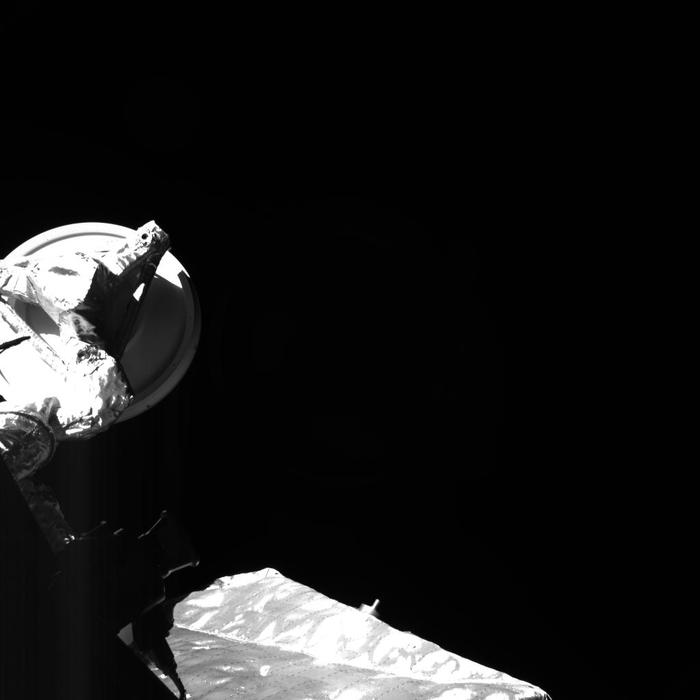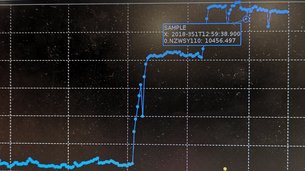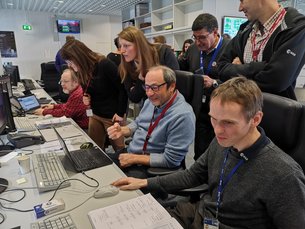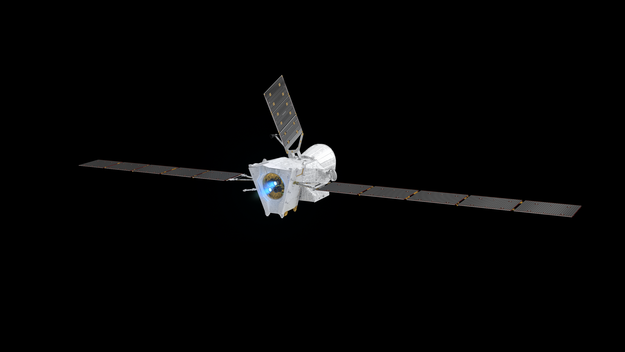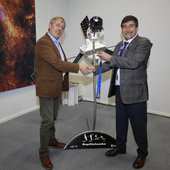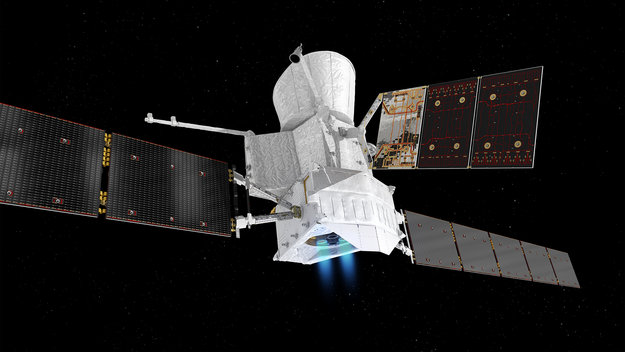19.12.2018

BEPICOLOMBO’S FIRST ROUTINE FIRING IN SPACE
On Monday this week, BepiColombo began its very first routine electric propulsion firing.
After meticulous testing of the spacecraft's four high-tech ion thrusters, the mission team have now fired up the spacecraft for its first thruster burn ‘arc’.
Travelling nine billion kilometers in total, BepiColombo will make nine flybys at Earth, Venus and Mercury, looping around the Sun 18 times.
To do this, the ESA/JAXA mission will be steered by 22 thruster burn arcs, each providing the same acceleration from less fuel compared to traditional, high-energy chemical burns that last for minutes or hours.
This first arc will last two months, during which BepiColombo’s electric blue ‘jet packs’ will steer the explorer on its interplanetary trajectory and optimise its orbit, ahead of its swing by of Earth in April 2020.
At 09:35 CET, before the thrusters began firing, BepiColombo was ‘slewed’ into the correct position. As its orientation shifted, the spacecraft’s high-gain antenna swivelled to maintain communication with ground stations on Earth, captured in this gif taken by the monitoring camera #3.
Next, BepiColombo’s solar arrays were tilted to fully face the Sun, as full power is needed to power the ion thrusters.
At about 13:45 CET, BepiColombo began to fire. The team watched with concentration and relief as graphs showed the spacecraft was gaining momentum, as two of its thrusters went from the initial thrust level of 75 millinewtons (mN) up to 108 mN each.
BepiColombo’s maximum planned thrust level for the entire journey is 250 mN, with two thrusters each firing at 125mN. This is equivalent to 250 ants pulling the 4 tonne BepiColombo spacecraft all the way to the innermost planet of the Solar System!
Click here to find out more about the tests that made this milestone moment possible, and re-live the moment itself from our live twitter feed from the day.
Quelle: ESA
----
Update: 18.01.2019
.
BELA - Die Vermessung des Merkurs

Simulierte BELA-Bodenspuren am Beispiel des Kraters Warhol. Die Punkte geben den Auftreffpunkt einzelne Laser-Schüsse auf dem Boden wider. Im Krater sind die typischen terassenförmigen Strukturen und die Kraterebene mit dem Zentralberg gut zu erkennen. Rechts davon befinden sich sogenannte "Hollows", Vertiefungen, die vermutlich nach Ausgasung flüchtiger Materialien als Hohlräume zurückbleiben. Das Bild zeigt einen Ausschnitt von 145 x 145 km.
BELA, das BepiColombo LaserAltimeter, ist eines von insgesamt elf Instrumenten an Bord des MPO (Mercury Planetary Orbiter) der BepiColombo-Mission zum Merkur. Mit dem Start am 20. Oktober 2018 vom Weltraumbahnhof Kourou in Französisch-Guayana wurde das Instrument auf seine lange Reise zum Merkur gebracht. BELA wurde vom DLR-Institut für Planetenforschung in Zusammenarbeit mit der Universität Bern, dem Max-Planck-Institut für Sonnensystemforschung und dem Instituto de Astrofísica de Andalucía entwickelt und gebaut. Die Anfänge von BELA reichen bis in das Jahr 2003 zurück, als die Planetenforscher des DLR mit den genannten Partnern die sogenannte "Phase 0" des Projektes begannen. Das DLR-Institut für Planetenforschung hat dabei die Verantwortung für den Sendeteil (Transmitter) sowie der Hauptelektronik des Instrumentes übernommen.
BELA dient der Vermessung der Oberfläche des Merkurs. Neben der Form des Planeten und der Topographie können die Ausmaße der Gezeiten vermessen werden, denen der kleine Planet in unmittelbarer Nähe zum enormen Schwerefeld der Sonne ausgesetzt ist und das ihn bei seinem Sonnenumlauf verformt, außerdem können die Rauigkeit beziehungsweise das Rückstrahlverhalten (die Albedo) der Oberfläche bestimmt werden.
BELA gewinnt diese Daten, indem zehn Mal in der Sekunde ein Laserpuls auf die Merkur-Oberfläche geschossen wird, dieser von dort reflektiert wird und wieder von BELA empfangen wird. Aus der Laufzeit des Pulses kann BELA die Entfernung der Raumsonde zur Planetenoberfläche mit einer Genauigkeit von bis zu 10 cm bestimmen – und das bei 1000 km Orbithöhe! Weiterhin werden die empfangenen Pulse zeitlich hochgenau aufgelöst und es können Informationen über die Oberflächenbeschaffenheit gewonnen werden. BELA wird während seiner Missionsdauer ca. 250 Mio Pulse analysieren und aus diesen Messdaten die oben genannten wissenschaftlichen Datensätze erzeugen.

Hier gibt es zudem eine ausführliche Beschreibung von BELA.
Im Jahr 2013 wurden die oben erwähnten Baugruppen bei der Universität Bern mit dem Empfangsteil kombiniert, um dann als komplettes BELA-Instrument im Jahr 2015 an die ESA abgeliefert zu werden.

Nach der Integration von BELA auf den Mercury Planetary Orbiter (MPO, der ESA-Merkurorbiter dieser europäisch-japanischen Mission) sowie umfangreicher Tests wurde der MPO inklusive BELA im Mai 2018 schließlich nach Kourou transportiert, um auf den Start vorbereitet zu werden.
Unter anderem wurden die sogenannten "Red Tag Items" von den Aperturen (Öffnungen der beiden optischen Komponenten) von BELA entfernt. "Red Tag Items" sind Schutzkappen, die das empfindliche Instrument während der Arbeiten am Boden vor Beschädigung und Verunreinigung schützen, aber natürlich vor dem Start entfernt werden müssen. Sonst wäre das Instrument "blind". Dieser Schritt musste sehr sorgfältig durchgeführt werden und wurde entsprechend von den DLR-Planetenforschern begleitet.

Das BELA-Team am DLR-Institut für Planetenforschung ist für den Betrieb des Instrumentes kurz nach dem Start, während der Reise zum Merkur und natürlich für die Missionszeit im Merkurorbit verantwortlich. Die von der Raumsonde gesendeten BELA-Rohdaten werden beim Europäischen Weltraumkontrollzentrum (ESOC) in Darmstadt empfangen und nach Berlin weitergeleitet. Hier wird das BELA-Team die Daten aufbereiten und analysieren, um die wissenschaftlichen Informationen zu gewinnen. Die während der Reise aufgenommenen Daten sind jedoch noch ohne wissenschaftlichen Wert, denn das Instrument "sieht" während der Reise zum Merkur weder den Sternenhimmel noch die Oberfläche der Planeten Erde, Venus und Merkur, an denen BepiColombo während der Reisephase zum Zweck von Swing-By-Manövern vorbeikommen wird. BELA blickt nämlich auf das Mercury Transfer Modul (MTM), welches den MPO und den japanischen Magnetospheric-Orbiter (MMO) zum Merkur bringt. Die beiden Sonden und das MTM werden sich erst 2025 trennen, wenn die Umlaufbahnen um dem Merkur erreicht wird.

Der Start am 19. Oktober 2018 war turbo-spektakulär – ein Nachtstart an Bord einer Ariane 5 in den klaren Tropenhimmel über Kourou – sensationell! Ein Teil des BELA-Teams war in Kourou vor Ort und begleitete die letzten Checks des Instrumentes kurz vor dem Start. Alle diese letzten Aktivitäten auf der Erde verliefen problemlos.
Am 26. November wurde BELA das erste Mal nach dem Start eingeschaltet. Einige Kollegen aus dem BELA-Team reisten hierfür zum ESOC nach Darmstadt, um von dort die ersten Kommandos an BELA zu schicken und die ersten Telemetriedaten von BELA sofort auszuwerten. Dieses sogenannte "Commissioning" verlief ohne Probleme. Alle Telemetriedaten lagen in den erwarteten Toleranzen. Bei diesem ersten Einschalten wurde noch nicht der Laser des Instrumentes getestet, aber dafür der komplette Empfangsteil. Hierbei konnte wie erwartet das elektrische Rauschen des Detektors und der Empfangsschaltkreise aufgezeichnet werden. Ein planmäßiges Software-Update wurde ebenfalls erfolgreich durchgeführt.

Nachdem auch dieser wichtige Meilenstein erledigt wurde, fiebern wir nun mit all den anderen WissenschaftlerInnen der elf MPO-Experimente und der fünf MMO-Instrumente während der langen Reise zum Merkur mit.
Erst im Jahr 2025 wird der MPO den Merkurorbit erreichen und BELA seine Arbeit aufnehmen. Warum das so lange dauert? Darauf könnte der Namensgeber der Mission, der italienische Ingenieur und Mathematiker Giuseppe "Bepi" Colombo (1920-1984) die beste Antwort geben: Mit Raumsonden in Richtung der Sonne zu fliegen ist nämlich recht kompliziert, denn die Anziehungskraft unseres Sterns ist so gewaltig, dass man große Mengen Treibstoff mitführen müsste, um am Merkur abbremsen und in eine Umlaufbahn gelangen zu können. Deshalb ist es aus energetischer Sicht günstiger, wenn die Raumsonde immer engere Ellipsen um die Sonne fliegt, die Schwerkraft der Erde und der beiden inneren Planeten bei gezielten Nahvorbeiflügen ("Swing-Bys") zum Abbremsen und Lenken nutzt und dann mit fast der gleichen Geschwindigkeit wie der Merkur selbst die Sonne umrundet. Ist dies geschafft, kann die Sonde viel leichter in eine Umlaufbahn um den Merkur eintreten. Bepi Colombo hatte eine solche Bahn in den 70er-Jahren für die erste Merkurmission berechnet, Mariner 10.
Glücklicherweise ist die Technik der Swing-bys schon bei vielen interplanetaren Missionen erfolgreich durchgeführt worden, so dass wir auf eine pünktliche Ankunft am Merkur im Dezember 2025 hoffen dürfen.
Quelle: DLR
----
Update: 6.04.2019
.
BEPICOLOMBO IS READY FOR ITS LONG CRUISE
Following a series of tests conducted in space over the past five months, the ESA-JAXA BepiColombo mission has successfully completed its near-Earth commissioning phase and is now ready for the operations that will take place during the cruise and, eventually, for its scientific investigations at Mercury.
BepiColombo started its seven-year long journey to the Solar System’s innermost planet on 20 October 2018, lifting off on an Ariane 5 rocket from Europe’s spaceport in Kourou, French Guiana.
After completing the launch and early orbit phase on 22 October, an extensive series of in-orbit commissioning activities started. During this near-Earth commissioning phase, which was concluded on 16 December, the European and Japanese mission teams performed tests to ensure the health of BepiColombo’s science instruments, its propulsion and other spacecraft platform systems.
On 26 March 2019, a review board confirmed that the overall capabilities and performance at the end of the near-Earth commissioning phase meet the mission requirements.
“We are very pleased with the performance of BepiColombo and proud of the work of all teams who made such a challenging mission a reality”, says Ulrich Reininghaus, ESA BepiColombo project manager.
This marks the end of the commissioning activities, and the operations team can focus on routine operations and on preparations for the mission’s first planetary gravity assist next year.
“BepiColombo has successfully passed its health check and is now officially in operations,” says ESA mission manager Patrick Martin.
The mission comprises two science orbiters: ESA’s Mercury Planetary Orbiter (MPO) and JAXA’s Mercury Magnetospheric Orbiter (MMO). The ESA-built Mercury Transfer Module (MTM) will carry the orbiters to Mercury using a combination of solar electric propulsion and gravity assist flybys – one of Earth, two at Venus, and six at Mercury – prior to MPO and MMO orbit insertions.
The first electric propulsion ‘arc’ started on 17 December, after verification of the four individual thrusters as well as the so-called ‘twin firing’ configuration, operating two thrusters in close proximity for a prolonged period of time, which was monitored closely by the operations engineers. The solar propulsion arc – the first in a series of 22 – was successfully completed in early March.
"Solar electric propulsion is one of the key flight challenges of this complex mission, and we are very pleased to see the system now in full operation," says Elsa Montagnon, BepiColombo spacecraft operations manager.
Since launch, BepiColombo has already covered over 450 million km – just about four percent of the total distance it will have to travel before arriving at Mercury at the end of 2025. The composite spacecraft is now some 50 million km from Earth, and telecommands take about three minutes to reach it.
The near-Earth commissioning activities for all science instruments on both orbiters have been completed as planned, and both ground segments – on the operations and science sides – are ready to support the next chapter of the mission.
“Besides the health checks that were successfully executed on all instruments, several of them are already operated in full science mode. The instrument teams are ready to go,” says ESA project scientist, Johannes Benkhoff.
In the coming weeks, the BepiColombo teams will investigate some remaining issues and carry out high-voltage related instrument checks while looking forward to the next major mission milestone, as the spacecraft will come back to some 11 000 km from Earth for a flyby on 13 April 2020.
Later next year, in October, BepiColombo will perform the first of its two flybys of Venus – the second planned for August 2021. These will provide an exciting opportunity to operate some of the instruments on both orbiters and to collect scientifically valuable data to further study this fascinating planet while en route to the mission’s destination – Mercury.
Quelle: ESA
----
Update: 21.06.2019
.
MONITORING CAMERA CHECKOUT


- Title Monitoring camera checkout
- Released 17/06/2019 11:00 am
- Copyright ESA/BepiColombo/MTM , CC BY-SA 3.0 IGO
- Description
How many times have you taken a selfie and posted it instantly to your favourite social media channel? The Mercury Transfer Module of the BepiColombo spacecraft, currently en route to Mercury, is equipped with three ‘selfie-cams’ and this morning captured a series of snapshots and subsequently posted them to its Twitter account.
The images were taken on 17 June between 04:13 UT and 04:51 UT and downlinked to Earth at around 07:20 UT.
The monitoring cameras take black-and-white images in 1024 x 1024 pixel resolution. The cameras point in three different directions, capturing one of the transfer module’s 15 m-long solar arrays (left), and the medium (middle) and high-gain (right) antennas attached to the Mercury Planetary Orbiter. The third spacecraft module, the Mercury Magnetospheric Orbiter, cannot be seen in these views.
After launch last October the monitoring cameras were used to view the deployed structural elements, and since then are used to visually record changes – for example if commands are sent to rotate the solar arrays or to change the pointing of the high-gain antenna, which is oriented towards Earth.
MCAM-3 is used most frequently, to monitor the rotation of the high-gain antenna. In December, MCAM-1 was used to capture a rotation sequence of the MTM’s solar arrays. Given MCAM-1 and -2 had not been used for several months, the images presented here were taken as a simple checkout of the cameras and made quickly available to share on ESA’s channels.
While the Mercury Planetary Orbiter is equipped with a high-resolution scientific camera, this can only be operated after separating from the Mercury Transfer Module upon arrival at Mercury in late 2025 because, like several of the 11 instrument suites, it is located on the side of the spacecraft fixed to the transfer module during cruise.
Check out this 3D tool to view the attitude of the spacecraft, including simulated views from each of the monitoring cameras.
BepiColombo launched from Europe’s Spaceport in Kourou on an Ariane 5 on 19 October 2018 (20 October European time). It is a joint endeavour between ESA and the Japan Aerospace Exploration Agency, JAXA. It is the first European mission to Mercury, the smallest and least explored planet in the inner Solar System, and the first to send two spacecraft – ESA’s Mercury Planetary Orbiter and JAXA’s Mercury Magnetospheric Orbiter – to make complementary measurements of the planet and its dynamic environment at the same time.
Quelle: ESA
----
Update: 1.04.2020
.
Lean team readies ESA’s Mercury-bound BepiColombo for planetary flyby

One job deemed essential by the European Space Agency during the coronavirus pandemic involves shepherding the BepiColombo spacecraft through a high-speed flyby of planet Earth next month, an immovable event on the $1.8 billion mission’s seven-year journey to Mercury.
The priority assigned to BepiColombo’s April 10 flyby means a limited team of engineers will be stationed inside the European Space Operations Center, located in Darmstadt, Germany, to oversee the spacecraft’s passage by Earth.
Meanwhile, other ESA science missions have suspended regular operations after officials reduced workforce levels at the control center in Germany. Last week, ESA announced the first positive test result for the COVID-19 coronavirus among the workforce at ESOC.
“Our priority is the health of our workforce, and we will therefore reduce activity on some of our scientific missions, especially on interplanetary spacecraft, which currently require the highest number of personnel on site,” said Rolf Densing, ESA’s director of operations, in a March 24 statement.
ESA said it was suspending instrument operations on four solar system science missions, including the Solar Orbiter spacecraft, which launched last month from Cape Canaveral. Solar Orbiter is on the first leg of a mission that will use a series of gravity assist flybys of Venus and Earth to slingshot closer to the sun, eventually arriving in an orbit to image the sun’s poles for the first time.
When the coronavirus pandemic impacted operations at ESOC, Solar Orbiter was not yet finished with its post-launch commissioning and instrument checkouts.
“ESA expects to resume these operations in the near future, in line with the development of the coronavirus situation,” the agency said in a statement.
Other ESA missions that have paused science operations are the four Cluster spacecraft orbiting Earth to investigate our planet’s magnetic environment, the Mars Express spacecraft that has orbited the red planet since 2003, and the ExoMars Trace Gas Orbiter, which arrived in orbit around Mars in 2016.
“These have stable orbits and long mission durations, so turning off their science instruments and placing them into a largely unattended safe configuration for a certain period will have a negligible impact on their overall mission performance,” Densing said in a statement.
But BepiColombo is coming up on a major milestone on its 5.5-billion-mile (8.9-billion-kilometer) voyage to Mercury, where the mission is scheduled to arrive in December 2025. BepiColombo launched in October 2018 and is on track for its first planetary flyby April 10.
The spacecraft will use Earth’s gravity to bend its trajectory inward toward the sun, taking aim on Venus for the mission’s next gravity assist maneuver Oct. 15.
“This is the last time we will see BepiColombo from Earth,” said Joe Zender, BepiColombo’s deputy project scientist at ESA. “After that it will head deeper into the inner solar system.”

Personnel at ESOC will maintain social distancing guidelines throughout the flyby, according to ESA. While some employees at the control center can work remotely, the high-stakes, fast-paced planetary encounter April 10 requires some staff to work onsite.
“The Earth swing-by is a phase where we need daily contact with the spacecraft,” said Elsa Montagnon, BepiColombo spacecraft operations manager at ESA. “This is something that we cannot postpone. The spacecraft will swing by Earth independently in any case.”
BepiColombo consists of two orbiters — one from Europe and one from Japan — connected with a transfer module to generate solar power and generate thrust from four ion engines.
Once at Mercury, the European Mercury Planetary Orbiter and the Japanese Mercury Magnetospheric Orbiter will separate to enter their own orbits and perform independent measurements at the solar system’s innermost planet.
At the time of closest approach April 10, BepiColombo will reach a point roughly 7,900 miles (12,700 kilometers) from Earth.
“During the critical two weeks prior to the closest approach, we need to upload safety commands to prepare the spacecraft for unexpected problems,” says Christoph Steiger, BepiColombo deputy spacecraft pperations manager. “For example, we need to prepare the transfer module for the 34 minute-long eclipse when its solar panels will not be exposed to sunlight to prevent battery discharge.”
Scientists want to use BepiColombo’s flyby with Earth to test some of the spacecraft’s scientific instruments.
For example, an ultraviolet spectroscope on the Mercury Planetary Orbiter will observe the moon to help calibrate the instrument’s settings before arriving at Mercury.
“We also want to make some measurements of the solar wind and its interaction with Earth’s magnetic field,” said Johannes Benkhoff, ESA’s project scientist for the BepiColombo mission. “The main purpose of having the instruments on at this stage, however, is testing and calibration. If we can use the data for some scientific investigation, it will be a bonus.”
Three on-board “selfie” cameras — positioned to see parts of the spacecraft’s antennas and solar panel — will take a series of images as BepiColombo approaches Earth.
“We will see the Earth approaching and getting bigger,” Zender said. “When it reaches the nearest point, we will take a few images, and then we are planning to capture a whole sequence of photographs over several hours looking at the Earth-moon system as it gets smaller and smaller until we lose it completely.”
BepiColombo will next encounter Venus on Oct. 15, and then again in August 2021. Those gravity assist maneuvers will set up a sequence of six flybys with Mercury before entering orbit around the rocky world in December 2025.
BepiColombo’s European-built science orbiter will map Mercury and study the planet’s geologic history, while the Japanese component of the mission will observe the solar wind’s influence on Mercury.
Besides the four ESA missions no longer collecting science data, officials said ESA’s coronavirus protection measures at ESOC have not affected any other spacecraft operations.
ESA’s astronomy and Earth observation missions are able to continue with just a single technician in the control room at ESOC, the agency said. Other support functions for those mission can be accomplished remotely.
Quelle: SN
----
Update: 5.04.2020
.
Say hello – wave goodbye to BepiColombo

The Airbus built BepiColombo mission will make a fly-by past Earth on 10th April 2020 as it continues on its epic journey to Mercury.
The joint European Space Agency and Japanese Space Agency spacecraft will swing past Earth at about 13,000 km away, closer than navigation satellites (GPS, Galileo). It will be BepiColombo’s final glimpse of Earth before it continues on its seven year, 8.5 billion kilometre journey to the Solar System’s innermost, smallest and least explored planet, Mercury. The last time the spacecraft saw Earth was 18 months ago in October 2018, when it was launched on an Ariane 5.
BepiColombo is not due to arrive at Mercury until 05th December 2025, but to get there safely and at the right speed to be captured by Mercury’s gravity, it must do nine flybys of the inner planets, one past Earth, two at Venus and six flybys at Mercury. After arrival, the spacecraft will capture data for a year with the possibility of extending the mission.
BepiColombo will collect measurements to study the composition, geophysics, atmosphere, magnetosphere and history of Mercury as well as testing Einstein’s theory of general relativity. The 16 scientific instruments will also provide insights into the characteristics of Mercury’s magnetic field and how it interacts with the solar wind.
Philippe Pham, Head of Earth Observation, Navigation and Science said: “This flyby marks a great achievement and major milestone for Airbus. Teams across five countries worked together to successfully develop and launch the spacecraft on a complex mission to Mercury.”
The journey will total some 8.5 billion km, completing 18 orbits around the Sun before entering the spacecraft’s operational orbit and beginning scientific exploration of the planet Mercury.
@BepiColombo @ESA_Bepi @esascience @JAXA_MMO #Airbus #Mercury
Quelle: Airbus
+++
Spot BepiColombo during its ‘goodbye flyby’
On 10 April, BepiColombo will be visible to amateur and professional astronomers during its first – and only – Earth flyby, as the spacecraft makes its way to Mercury, the innermost planet of the Solar System. The best place to spot it is the southern hemisphere, but observers in southern locations of the northern hemisphere might also catch a parting view of the spacecraft.
By the time of the flyby, BepiColombo will have travelled almost 1.4 billion km – roughly nine times the distance between Earth and the Sun – since the European-Japanese mission was launched in October 2018. Yet, passing over at an altitude of just 12 700 km, it will come within just a couple of thousand kilometres of our planet’s exosphere, the outermost layer of the atmosphere, providing us with the last chance to say hello – and goodbye.
This is the first of a series of nine gravity-assist manoeuvres that the spacecraft will use to reach its final destination. The next two flybys will see BepiColombo proceed towards Venus in October 2020 and August 2021, respectively, followed by six flybys of Mercury itself to further adjust the trajectory. Eventually, the mission’s two science orbiters – ESA’s Mercury Planetary Orbiter and Mio, the Mercury Magnetospheric Orbiter of the Japan Aerospace Exploration Agency (JAXA) – will separate from the Mercury Transfer Module in late 2025 and start their scientific operations at Mercury in early 2026.
Say goodbye to BepiColombo

BepiColombo will make its closest Earth approach at 05:24:58 BST (06:24:58 CEST) on 10 April 2020 as it crosses the sky from East to West. The spacecraft will not be visible to the naked eye, but observers with access to a small telescope, binoculars or a camera might be able to catch the Mercury explorer as it bids farewell to our home planet.
“The flyby has an emotional effect,” says Johannes Benkhoff, BepiColombo Project Scientist at ESA.
“It’s the last time that we can see the spacecraft from Earth, so we are inviting amateur and professional astronomers to observe it before it goes.”
The scheduled flyby takes place as billions of people across the world face an exceptional situation caused by the ongoing coronavirus pandemic, which limits human movement and therefore also the access to many professional telescopes. Amateur astronomers in suitable locations, far from large cities, can contribute from their home terrace or garden.
“BepiColombo should be visible with a small telescope, accessible to amateur astronomers in the southern hemisphere or in southern parts of the northern hemisphere,” adds Joe Zender, ESA BepiColombo Deputy Project Scientist.
“If you live in southern Europe – south of Rome or Madrid, for example – you might be able to glimpse it for a moment, and the further south you are, the longer you should be able to see it. If something appears as a moving star in the field of view of your telescope or camera, that will be Bepi.”

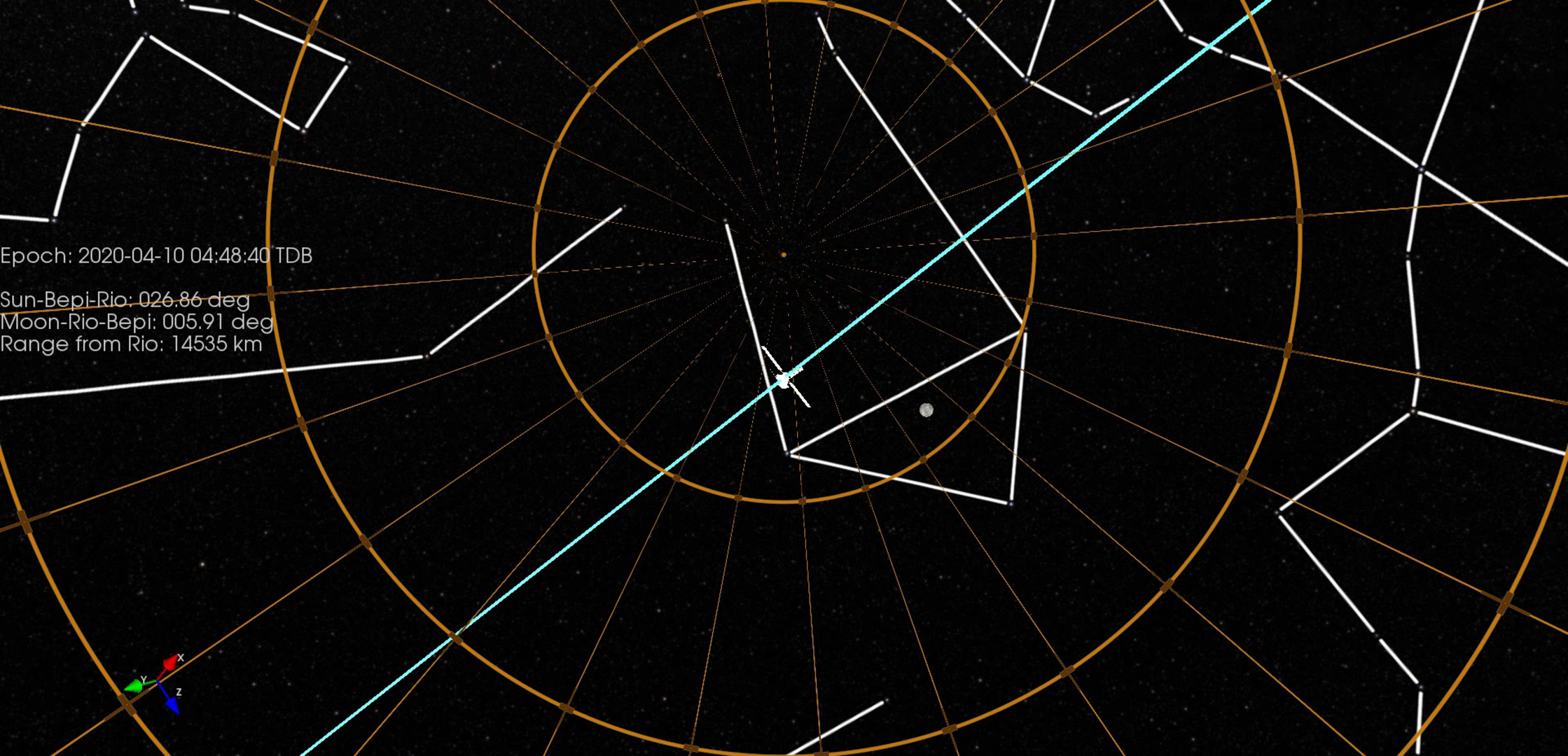
Access the video
The planets Jupiter, Saturn and Mars – visible to the naked eye – will also be in the sky in the early hours of 10 April, providing an interesting configuration for astro-photographers. Unfortunately, another bright source will be in the sky too, the Moon, making BepiColombo more challenging to observe.
“BepiColombo will be also visible from Japan in the late hours of 10 April, as it moves away from our planet,” says Go Murakami, BepiColombo Project Scientist at JAXA.
“The conditions are not the best but some professional observatories will try to observe it, along with amateur astronomers.”
Besides their symbolic value, the observations will be useful for scientists to calibrate some of the onboard instruments and check their science operations tools.
You can compute your own plot of BepiColombo’s motion across the sky for your location, by adding your latitude and longitude in this tool developed by a team of BepiColombo scientists from INAF, the National Institute for Astrophysics in Italy.
If you are up for the challenge, upload your pictures to this Flick-r group and post them on Twitter or Instagram using the hashtag #BepiColomboEarthFlyby for a chance to win a BepiColombo scale model and be published on the ESA website. If you do not use Flickr, you may submit your pictures to this form on the website of the Europlanet Society.
Under all circumstances, please remember to obey the appropriate social distancing rules and regulations of the country you reside in.
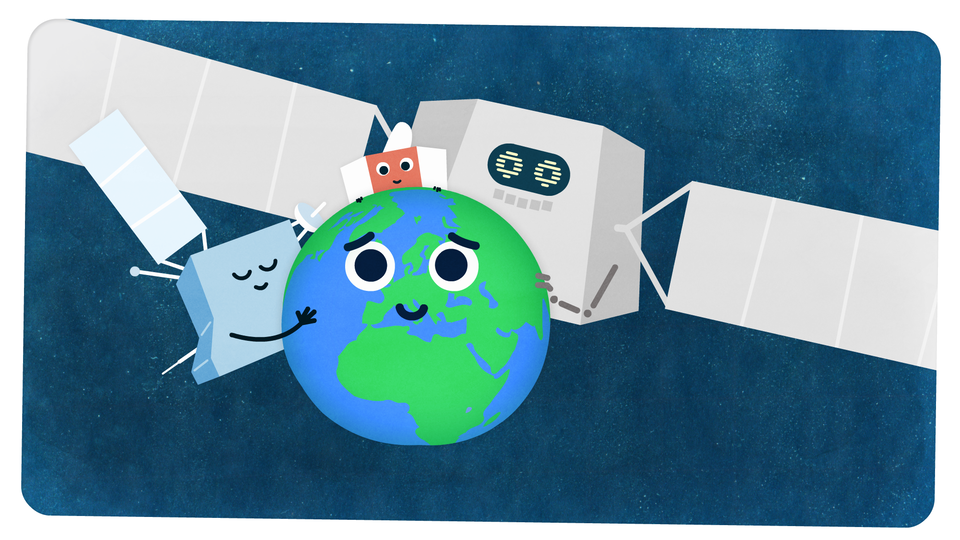
For anyone at northern latitudes or without access to telescopes and binoculars, follow @BepiColombo, @esaoperations and @esascience on Twitter for live updates.
The three spacecraft modules also have personalised accounts (@ESA_Bepi, @JAXA_MMO, and @ESA_MTM) that you may follow for extra content and a unique take on the mission.
Look out too for this real-time animation on the Heavens-Above website depicting the spacecraft’s position, as it edges closer and then disappears into the dark sky forever.
Quelle: ESA
+++
Why is BepiColombo back?

BepiColombo is on its way to Mercury, but for some reason that brings it back to Earth.
On 10 April 2020, BepiColombo will make a flyby of Earth, coming within just a couple of thousand kilometres of our planet’s outer atmosphere. Why? The spacecraft needs to shed ‘orbital energy’, and it will use our planet’s gravity to do so.

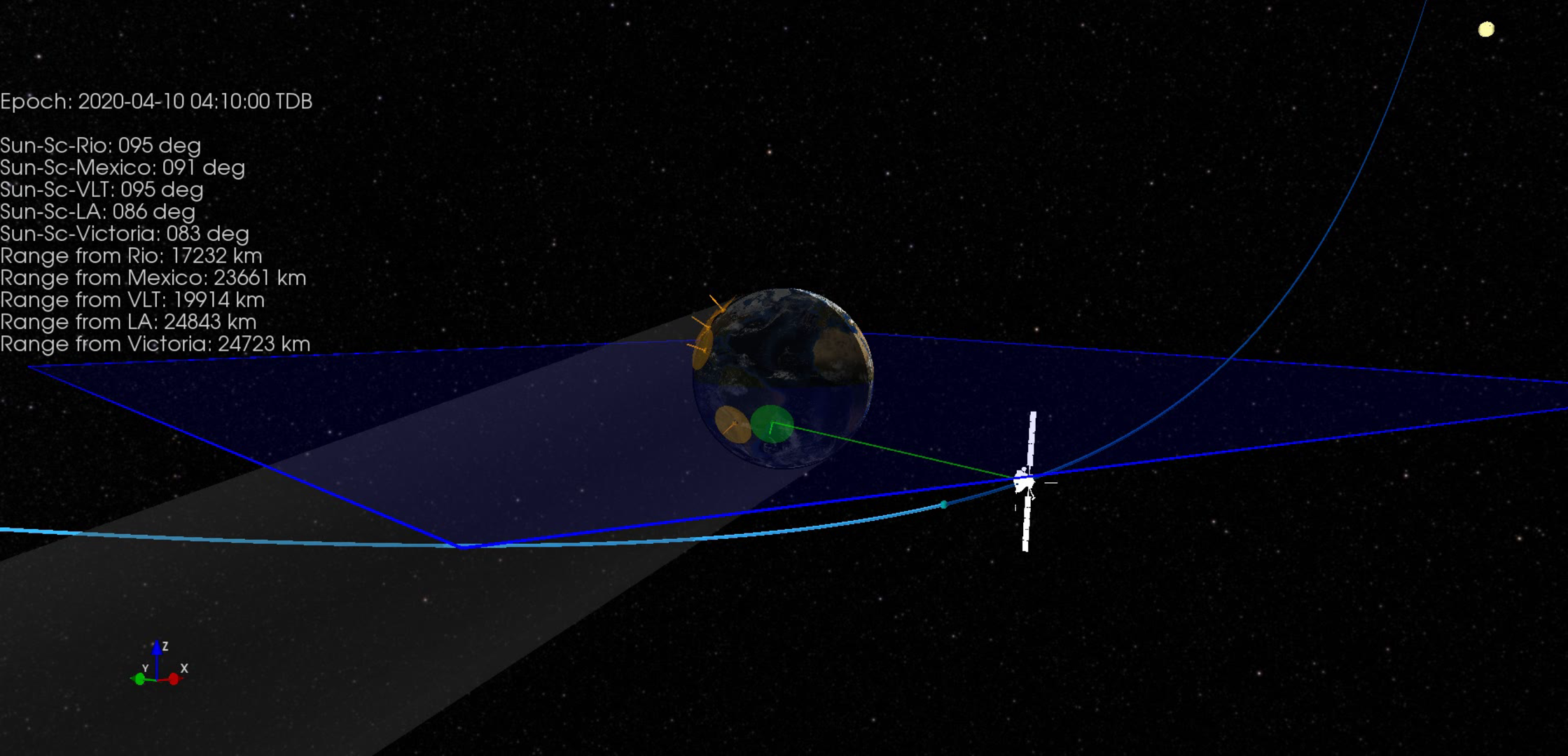
Access the video
According to Newton’s first law of motion, objects travel in a straight line, unless an external force makes them stop or change direction. Planets would travel in straight lines too, if not bound by the immense gravitational pull of massive stars.
In space, spacecraft rely on thrust from their own engines to speed up, slow down, or change direction – or even better, they can use the gravity of massive bodies they encounter along the way, like planets.
Gravity is free
The more gravity a spacecraft can take advantage of, the less fuel it needs on board, and the more scientific instruments it can carry – and BepiColombo is carrying a lot of instruments.
By flying close to planets as they sweep through space, a spacecraft can use their enormous gravitational pull to ‘exchange‘ a little of their ‘orbital energy’. The larger the orbit a spacecraft, or planet, is travelling in, the greater its orbital energy.

To get to Mercury, BepiColombo has to match its much smaller orbit (the smallest of all the planets in the Solar System), and to do so it has to shed some of its orbital energy.
With careful planning, depending on when, where and in what direction the spacecraft approaches, the gravitational pull of a speeding planet can change its direction and speed, without using any fuel at all.
Slowing down for Mercury
The upcoming Earth flyby will be BepiColombo's first and only visit home before it performs two more gravity-assists at Venus – the first one in October, the second one next year – and six at the scorched planet itself. It will enter Mercury’s orbit in 2025.

During this milestone flyby, BepiColombo will use Earth to reduce its orbital energy and change its trajectory, bringing it toward the inner solar System,” explains Elsa Montagnon, BepiColombo Spacecraft Operations Manager for ESA.
“Thanks to this manoeuvre, BepiColombo will slow down by almost five kilometres a second, putting it on track to visit Earth’s ‘twin’ of a similar size, but very different composition, Venus”.
Several small trajectory correction manoeuvres have been executed before the flyby, and one is expected after, using the electric blue ion propulsion system of the Mercury Transfer Module, the ESA-made ‘bus’ carrying the two science orbiters that make up the mission, ESA’s Mercury Planetary Orbiter and JAXA’s Mercury Magnetospheric Orbiter, also known as Mio.

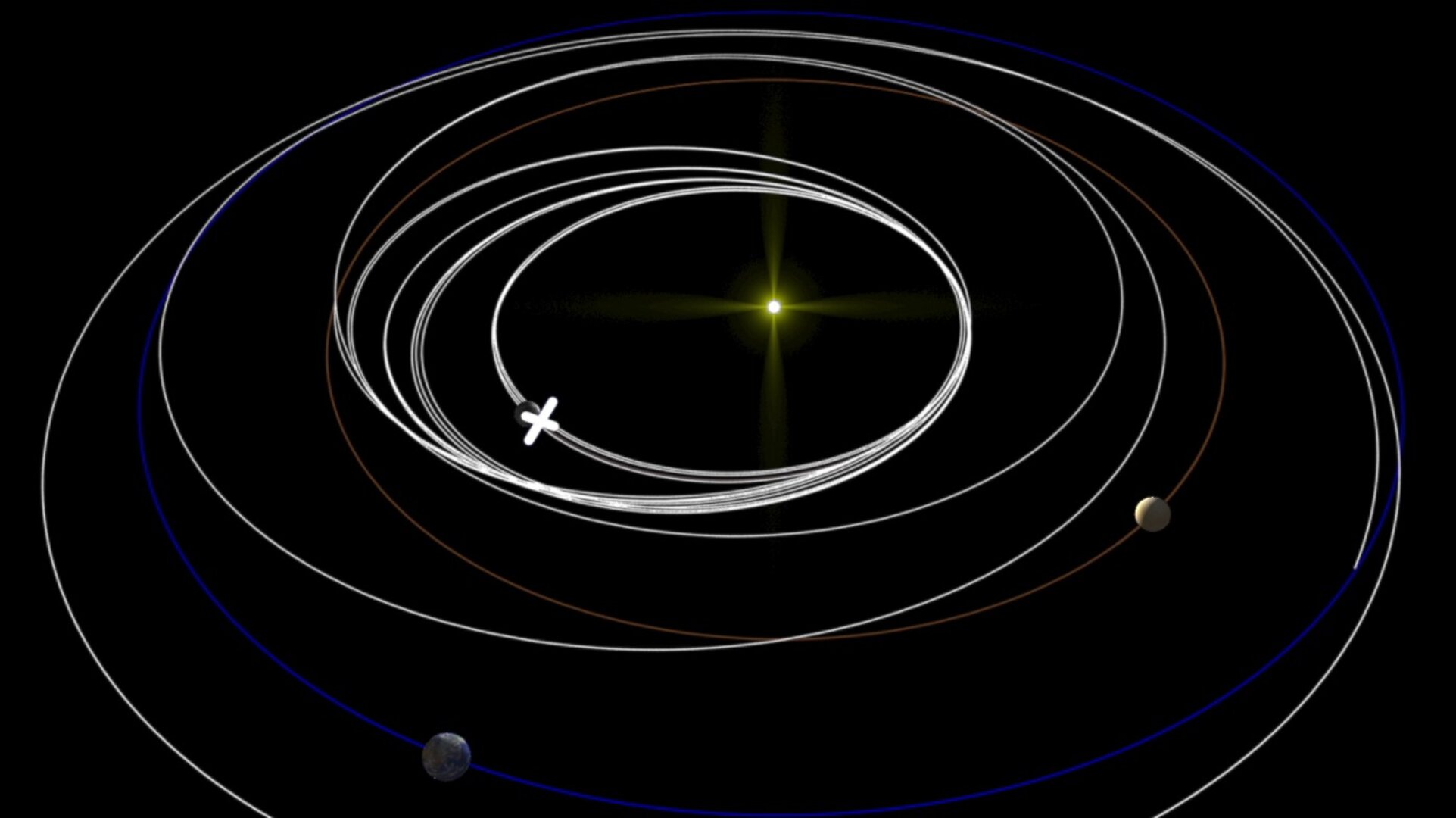
Access the video
“The speed at which BepiColombo orbits the Sun will be much slower right after the swing-by on 10 April than it was before,” explains Michael Khan, Head of Mission Analysis at ESA.
“The swing-by will have robbed BepiColombo's orbit of a lot of energy, without having to fire its engines or even using much fuel. Just, instead, with clever use of the laws of physics.”
Follow the flyby
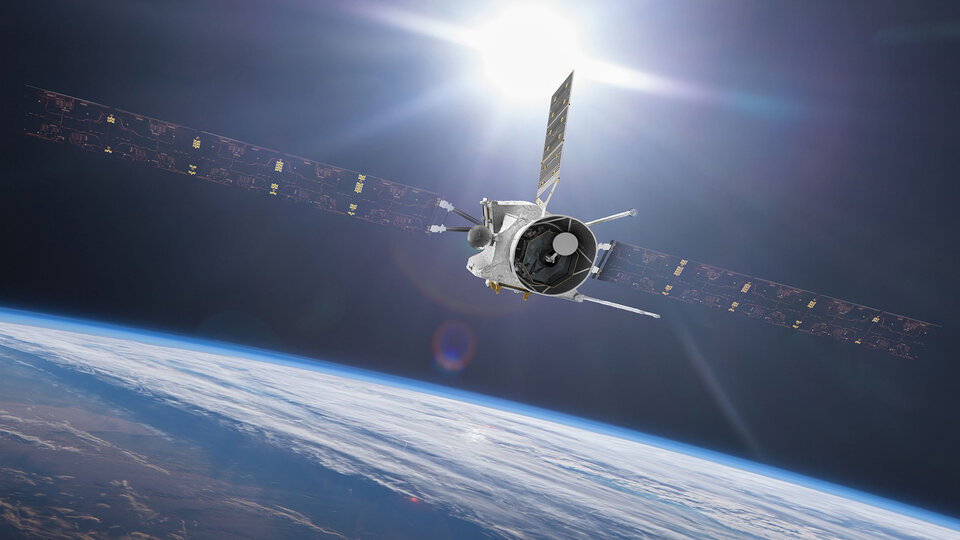
For observers in the Southern Hemisphere, or southern parts of the Northern Hemisphere, it may be possible to catch a glimpse of BepiColombo if you have a telescope or even a good pair of binoculars.
For everyone else, get live updates via @BepiColombo on Twitter, and get an idea of where the spacecraft is on the live animation that will be streamed on @esaoperations.
Quelle: ESA


